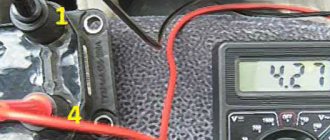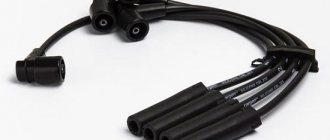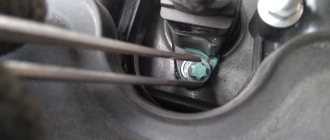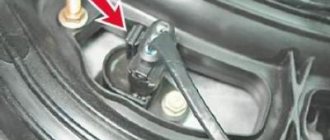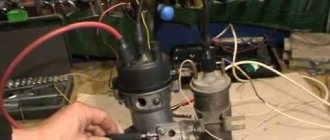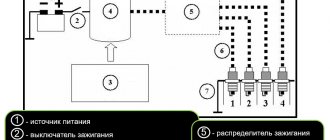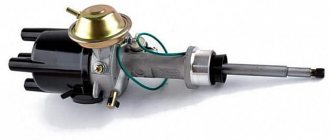How to check spark plugs yourself
You can check the presence of a spark and, in general, operability, in several ways:
- Start the engine and pull out the high-voltage wires from the spark plugs one by one. If the spark plug does not work, the sound and vibration of the internal combustion engine will not change. And, if you disconnect the wire from a working spark plug, you will immediately feel changes in the operation of the motor.
- Turn off the engine. Unscrew the spark plug, place the thread on the body, for example, on the valve cover, and a second person turns the ignition key. It is better for the person holding the candle to hold it with rubber gloves or let it go altogether. His task is to see if there is a spark, and what kind of spark it is.
- A special device for checking spark plugs is a pistol. A spark plug is inserted into the gun and it is determined whether there is a spark or not.
- A homemade device for testing candles - a piezo lighter with a wire. Connect the wire from the piezo lighter module to the removed candle and place the piezo lighter block itself on ground, then press the button on the block.
- There is also a pressure test method. But why use all sorts of complicated methods when the first two methods of checking spark plugs are the most effective.
How to check the spark
From time to time you have to check the performance of the spark plugs to find out some of the reasons for unstable operation. There are 3 ways to check spark plug sparks:
- We check for weight.
- We check with an electronic measuring instrument (multimeter).
- Manual mechanical military method of checking spark. The essence of the method is to make a gap of 4 mm. If the spark hits exactly in the middle, then this is a perfectly working spark plug. If with such a gap the spark hits the side, then this is a poorly functioning spark plug.
Signs that you need to check the spark plugs for a spark:
- interruptions at idle speed;
- engine tripping;
- twitching while moving;
- fuel consumption has increased.
Why there is no spark, reasons:
- the candles were flooded;
- broken high-voltage wires;
- contact is broken;
- The crankshaft sensor has failed;
- the ignition module has failed;
- the ignition coil (bobbin) has failed;
- the switch has failed;
- faulty distributor;
- the service life has expired (usually the service life is up to 50 thousand km);
- large layers of soot on the electrodes of the spark plugs (due to low-quality fuel and over-suction);
- presence of oil on the electrodes (excess oil and worn rings);
- varnish and slag deposits on the electrodes (due to various additives in oils and fuels);
- melted candles;
- mechanical damage to the composite spark plug;
- ground contact is poor;
- The electronic control unit (ECU) is not working correctly.
How to check spark on ignition coil
The ignition coil is not one of those units that constantly breaks down and causes other troubles, but in some cases problems are still noted. The most common cause of problems is winding damage. The subsequent breakdown of the insulation layer leads to a short circuit. The coil can also be damaged as a result of overloads caused by faulty spark plugs, or defects in the high-voltage wires themselves.
Before checking the spark on the ignition coil, it is advisable to drive the car into a dry garage. All work can be done independently, without the use of special equipment. The algorithm for such a check is standard.
- After cleaning the distributor cover from dirt, it is removed.
- By turning the crankshaft on the engine, it is necessary to achieve the closure of the distributor contacts.
- After turning on the ignition, the high-voltage wire coming from the distributor is brought to the ground of the vehicle. Particular attention should be paid to the distance - it should be 5 mm.
- To ensure the accuracy of the coil test, from time to time you will need to manually open the contacts of the distributor.
- You can say that the coil is working properly if a bright blue spark appears. If it is weak, uncertain, appears only periodically or is completely absent, the coil must be replaced, since its repair, as a rule, is simply impossible. When installing a new one, the polarity must be strictly observed, otherwise the new coil will also fail. At specialized service stations, coils are checked on a special stand, which allows testing the performance of the device in various operating modes. A very simple way to quickly check is shown in the video:
Ignition coil: how to understand that there is no spark in it?
Before you begin to understand this issue, it is important to understand exactly what this node actually is. In principle, its main purpose is to convert current from low to high voltage. Well, if this element has any problems, then it will be impossible to start the vehicle. However, this mechanism, in the presence of disturbances, has its own characteristic symptoms. You can recognize that there is no spark in the coil by the following signs:
- There was a decrease in engine power;
- There were problems starting up;
- Fuel consumption has increased sharply;
- Periodically there are interruptions at idle.
If the motorist has identified the problem, and it turns out to be related specifically to the coil, then the next step is to begin repairs. It is quite possible to solve this problem yourself, without resorting to the help of service center specialists. First, the driver needs to inspect the element for any possible violations. Next, if, for example, dirt is found on the coil, it will need to be removed with a dry cloth. It is also very important to pay attention to the wiring itself. There should be no accumulation of moisture and various breaks on it.
More details about checking the ignition coil for functionality will be described in this video:
Checking the spark on the injection engine
Among the common malfunctions of an injection engine or carburetor engine is when the spark is lost on the spark plugs. In this case, the engine may not start or after starting it may function intermittently (triple), since there is no spark at one of the spark plugs and the cylinder actually does not work.
In such a situation, diagnosis should begin with checking the ignition system. In parallel with this, it is worth taking into account certain features and nuances depending on the type of engine installed. Next, we will talk about available ways to check the ignition for spark in relation to engines with a carburetor, and also consider what to do if the spark on an injection engine is lost.
Read in this article
Why the spark disappears: the main reasons
On different types of engines, there is a fairly wide list of reasons why there is no spark at the spark plugs. Among the main experts are:
- Problems with spark plugs (destruction of the spark plug body, defects in the electrodes, etc.). It is also worth noting that the spark plugs may be filled with fuel or oil, which indicates a breakdown of the engine itself.
- Malfunctions of high-voltage wires associated with insulation breakdown or lack of contact.
- Failure or errors in the operation of the crankshaft position sensor.
- Problems with the ignition module, ignition coil, switch;
- Malfunctions or malfunctions of the distributor.
- Deterioration or absence of ground contact.
- Errors related to the operation of the electronic engine control unit (ECU);
No spark on an injection engine or an engine with a carburetor: how to check
Checking the spark is possible using several methods: to ground, using a multimeter, or a special tester on a piezoelectric element. The first method is the simplest. The body of the unscrewed spark plug is brought to the metal (usually the engine cylinder block), after which the engine is cranked by the starter and the presence of a spark is analyzed.
Please note that this verification method cannot be used when diagnosing fuel-injected vehicles. The fact is that a car with an injector has an ECU and other electrical equipment that is quite sensitive and can be damaged.
The second method allows you to better assess the condition of the spark plug, identify breakdown, etc. The use of a special tester is a method of checking the spark on injector cars, reminiscent in its principle of checking by analyzing the spark breakdown to ground (the first method). In this case, the risk of burning the control unit is minimized. Now let's talk about how to check the spark on a fuel-injected engine.
A complete lack of sparking indicates possible problems with the controller, ignition module, coil or center wire. Diagnostics should begin by checking the fuses. Then you should evaluate the condition of the ground contact, and also check the high-voltage wires.
If there is no spark at the ignition coil, then the functionality of the high voltage wire should be checked. The specified wire must be checked for insulation integrity, have no breakdowns, burnt areas, etc. Detection of any defects is grounds for its replacement.
Also, in the process of diagnosing the ignition system, you should inspect the spark plugs. This must be done if electricity reaches the candles. On carburetor cars, it is enough to remove the spark plug wire, and then bring it closer to a metal surface (for example, a car body) by half a centimeter. Then you need to turn the starter and make sure that there is a spark running between the wire and the metal surface. The spark itself should also have a certain intensity, be white with a slight bluish tint. If no deviations are noticed, then the spark plugs are working. The reason that there is no spark at the spark plug may be the ignition coil.
If you notice problems with the spark plugs, then you need to pay attention to the spark plug contacts. These contacts must be free of contamination. Let us add that if deviations from the norm are noticed, it is optimal to immediately replace the spark plugs. Failure to do so will indicate the need to clean the contacts.
How to check the spark on a fuel-injected engine
One of the most important parts of your car's electrical system is the spark plugs. These parts ignite the fuel, and if the spark plugs stop working properly, the engine will experience certain problems. The spark plugs themselves do not break so often; most likely, other factors are to blame for the lack of a spark.
However, sometimes a candle that has already exhausted its service life cannot properly perform its working functions. Therefore, it is advisable for every driver to know how to check spark plugs on the road without special tools and diagnostic equipment.
The best way to check spark plugs is through timely maintenance and regular servicing of the machine.
The first symptoms of faulty spark plugs and lack of spark
The reasons for the failure of spark plugs in a car can be very different. But the symptoms are similar in most cases. The main indicator of the failure of one spark plug is that the engine begins to stall. When such an unpleasant aspect occurs, the power of the unit decreases, consumption increases, and the car shakes a little at idle. All this allows us to conclude that one of the cylinders is not working, in particular because there is no spark at the spark plug. The following symptoms of non-functioning spark plugs are also distinguished:
the car does not start, when you try to start the engine, the starter spins smoothly, there is no progress in the ignition; after starting, 2 or 3 cylinders work for some time, then the fourth one is connected - this is an indicator of the failure of the spark plug; the car constantly becomes difficult to start, the engine only starts on the third attempt; the car has lost power and responsiveness, pressing the gas pedal does not produce the desired effect; the car stalled during the trip, starting it is difficult or even impossible;
From time to time, during startup, strong pops are heard in the exhaust pipe - this is the fuel that has been pumped up but not burned.
When all the spark plugs do not work, this situation should alert the car owner. Most likely, the reason is not the spark plugs. But if one spark plug refuses to work, you should look at the spark plug itself, as well as at the wire that connects it to the coil. This will help you find out what exactly caused the problem in your car. And if testing sensors, switches and coils in the field is not an easy task, then testing spark plugs is quite possible.
How to check spark plugs without special equipment?
On the road, we often don't have any equipment to test spark plugs. Therefore, you have to make do with traditional methods to check all the subtleties of the car. In particular, in the case of candles, you can use one of the proven testing methods. First, you should unscrew the spark plug and take a closer look at it, obtaining information about its condition. If the spark plug is wet, it floods with gasoline and does not work. A dry spark plug means there is no fuel getting to it or everything is working properly. A black candle wick also indicates a problem. You can check for spark as follows:
unscrew the spark plug and put a high-voltage wire on it so that you can give a spark; grab the rubber part of the wire with your hand, but in no case grab the metal parts of the spark plug; place the spark plug wick at a distance of about 0.5 centimeters from the engine body - any metal parts; ask another person to turn the ignition key and try to start the engine for four seconds; if a spark appears and breaks through to the engine body, then everything with the spark plugs is in perfect order, you need to look for other problems;
if there is no spark, the spark plug does not work, and other not very pleasant problems are also possible.
If there is a spark, then the engine starting problem is related to the fuel system. If there is no spark, the culprit of your problems is the vehicle's electrical system. These will not necessarily be spark plugs, because the electrical system of a car contains quite a few different elements that can damage the spark plug assembly. You need to check everything to fully ensure that the equipment is working properly. By the way, the easiest way to check whether the spark plugs are working is to replace them with ones that are known to work.
What else could cause the spark plugs to not spark?
If there is no spark, many drivers confidently say that they need to change the spark plugs. But this is not always true. In particular, there are other modules that can affect spark production, so you need to check all the features of the vehicle's electrical system. If we are talking about the fact that the ignition system does not produce a spark, it is necessary to pay special attention to those modules that are responsible for this spark. Among them, you will have to check and suspect a malfunction of the following important machine modules:
high-voltage wires - often this element is the reason for the lack of a spark, the wire can pierce; ignition coils or distributor on old cars - frequent candidates for replacement and repair; switch - a part that rarely raises doubts about its operation; it breaks not so often, but very unexpectedly ;ignition switch - one of the contacts may move away and not give normal commands to the car engine;
an on-board computer that controls the actions of the vehicle's electrical system, including the ignition.
If one of these elements fails, the symptoms will also be similar to a simple spark plug failure. But replacing the spark plugs will not have any effect. If the switch or on-board computer breaks down, you will have to contact specialists and carry out quite expensive repairs. You cannot solve such problems on your own. It is also difficult to replace ignition coils in the field. However, this list of problems is not exhaustive.
Checking the ignition coil for spark
To diagnose the performance of the coil, remove the wire from the distributor-breaker. Next, the test is carried out similarly to testing high-voltage wires, that is, the wire is brought to a metal surface and turned with a starter. The presence of a spark will indicate in this case a problem with the ignition distributor; if there is no spark, then the problem lies in the coil.
First you need to check the distributor contacts. These contacts may oxidize, insulation damage is also possible, and the rotor itself may be faulty. Detecting problems with the rotor allows you to eliminate the problem by replacing it. When checking the ignition coil, you should identify possible defects in the integrity of the winding, burnouts and other signs that a short circuit is occurring inside. If such signs are found, the coil should be replaced or the ignition coil should be repaired.
Now let's take a closer look at ways to check the main elements of the ignition system. To do this, let's go back to the coil. As already mentioned, the most common cause of a malfunction is a damaged winding. Then an insulation breakdown occurs and a short circuit occurs. It is also important to understand that the coil can fail due to overload. Such increased loads occur as a result of problematic spark plugs or spark plug wires. For diagnosis you should:
- put the car in a dry parking, repair or other box. You can also use the garage. The main thing is that the humidity is not too high;
- Next, you will need to clean the distributor cover from dirt, after which the specified cover must be removed;
- then you need to turn the engine crankshaft so that the distributor contacts are closed;
- Now you can turn on the ignition and bring the high-voltage wire of the distributor 3-7 mm to ground;
This is interesting: Attackers can gain access to control your car
After evaluating the spark, you can decide whether the ignition coil needs to be replaced. Please note that repairing this element is often impractical. Also, when installing a new spare part, you should strictly adhere to the required polarity. If this is not done, then the new part will quickly become unusable after unqualified installation. Please note that car service centers use a special stand to check coils. Such equipment allows you to check the coil taking into account various operating modes.
To check the spark on the spark plugs if the distributor is working properly and there are no problems with the condition of the high-voltage wires, you need to unscrew the spark plugs from the engine. In addition to the contacts, you should look at carbon deposits, the degree of oiling of the electrodes, etc. For normal sparking, contamination must be cleaned. You should also check the gap between the electrodes, which is usually between 0.7 and 0.9 mm. If the gap is broken, then you can carefully bend the side electrode. This method is a temporary measure, but in some cases it allows you to drive from several tens to hundreds of kilometers without tripping the engine in case of problems with the spark plugs.
We also add that there are special pistol devices for checking spark plugs. Typically, such solutions are available from spark plug sellers in car dealerships or automotive markets. If there is such a possibility, then the spark plugs can be checked on similar equipment.
Coil
In the case of the coil, it can be characterized as a fairly reliable and durable element of the ignition system. It rarely fails and causes trouble for the car owner. But sometimes problems appear and need to be fixed.
Most often, problems with the coil are caused by damage to the winding itself. If this happens, a breakdown occurs in the insulation, which can cause a short circuit that is dangerous for injection engines.
Another reason for damage to the coil is considered to be overload caused by malfunctioning spark plugs or damage to the high-voltage wiring (high-voltage wires).
Before you start checking the spark on the coil, be sure to make sure that the room where the diagnostic work is being carried out is dry. You can do the test yourself, and no special devices or professional equipment are required.
Diagnostics is carried out according to a standard scheme, which involves performing several sequential procedures:
- Thoroughly clean the distributor cover from accumulated dirt. Only after this can it be opened and removed;
- After turning the engine crankshaft, it is necessary to close the distributor contacts;
- The ignition is turned on;
- The high-voltage wire coming from the distributor is brought to the ground of the car. It is important to ensure a distance of 5 mm;
- To increase the accuracy of the test, it is periodically necessary to manually open the distributor contacts.
If there is no spark: ignition module
The following symptoms indicate possible problems with the operation of the ignition module:
- at idle speed the engine troits;
- power decreases, the car accelerates poorly;
Engine vibration is most pronounced in two nearby cylinders, and the drop in thrust is more strongly felt during attempts to sharply accelerate the vehicle, that is, when the accelerator is pressed hard and sharply. In such a situation, the “check” light usually lights up on the dashboard of most cars.
If checking the spark plugs and high-voltage wires does not reveal any problems, then the ignition module should be checked with a tester. The test consists of connecting one output of the tester to the module connector, and powering the other to ground. Then the engine can be started. A tester reading of 12 V is evidence that the module is OK. A deviation in the instrument readings from the norm may indicate either the need to replace the module itself or to check/replace the corresponding fuses.
Video - What to do if there is no spark VAZ 21099
To conclude our story, we will give some practical tips designed to minimize not only the number of ignition coil failures, but also the number of checks of its performance:
Do not use a coil intended for use in a contact-type system in a contactless ignition system.
While operating the vehicle, carefully monitor the condition of the wires and ensure correct polarity when connecting them.
Strictly observe the rules and operating conditions of the vehicle recommended by the manufacturer and promptly respond to the occurrence of deviations in the operation of the ignition system.
Regularly monitor the condition of the central (high-voltage) wire. The high intensity of operation of this element requires exposure to high temperatures, which contribute to the formation of soot on its contacts. In addition, loose contact of the central wire terminal leads to melting of the mounting hole, which leads to failure of the entire unit.
Useful tips
Experienced car enthusiasts are well aware that spark plugs can fail at the most inopportune moment. For this reason, it is recommended to carry a spare set with you. The same can be said about the spark plug wires.
When working on the ignition system, extreme caution should be exercised as you may receive a severe electric shock. Insulated tools must be used.
Since spark plugs fail more often than other elements of the ignition system, checking for a spark always begins with them. Diagnostics can be done one by one. The procedure is carried out by unscrewing the spark plug from the cylinder head, then putting a cap and a wire from the coil on the spark plug, after which it is grounded to ground. The main indicator when checking while the starter is rotating is the spark itself and its quality.
When removing the spark plug wires from the ignition module, it is advisable to mark each wire. This will allow you to check and subsequently connect in a strictly defined order without the risk of mixing up the wires.
Signs of malfunction and checking injection nozzles without dismantling. Diagnostics of injector power supply, performance analysis. Tips and tricks.
Why does the starter turn normally, but the engine does not catch and does not start? Main causes of malfunction, checking fuel supply and ignition systems. Adviсe.
How to check engine performance using spark plugs. The main signs of engine malfunctions: the appearance of black, gray, red and white carbon deposits on the spark plugs.
Signs of malfunction or breakdown of the high-voltage spark plug wire of the ignition system. How to check car armored wires with your own hands.
Engine trouble: symptoms. Why does tripping occur and how to find the reason why the motor starts to trip. Checking power, ignition, compression, etc.
What does the color of carbon deposits on a spark plug indicate, and why does carbon deposits of one color or another form? How to clean spark plugs from carbon deposits with your own hands, tips.
Checking the switch, Hall sensor and ignition switch
Back along the circuit from the coil there is a voltage conversion switch. This device cannot be checked using a multimeter. Therefore, it is necessary to test replace the old switch with a new one. It is recommended to carry a spare device with you in such cases. If the reason was precisely the breakdown of the switch, then with the new device a spark should appear. If it is missing, the breakdown must be looked for elsewhere.
Perhaps the Hall sensor is faulty, which is why there is no spark on the VAZ 2109 carburetor. It will also not be possible to check it using a tester. We do the same as with the switch - install a new one. The difficulty is this: to get to the sensor, you need to disassemble the distributor.
If replacing the sensor does not produce results, we check the ignition switch. We set the multimeter to 20 V. Connect one probe to terminal B, the second to ground. If the battery is charged, the tester should show 12 V. If the voltage is significantly less, there is an open circuit in the lock contact group: either the wire is broken or the fuse is blown.
We look for the problem or completely replace the lock.
Symptoms of a problem
It is almost impossible to visually determine that there are problems with the current supply in the car. To diagnose, you should start the engine or drive the equipment at high speeds.
Before checking the ignition module, you should clearly know the symptoms of the “disease”. So, the first signals about problems with spark plugs:
- The vehicle's crankshaft rotates at the required speed, but the engine does not start. Due to the lack of a spark, there is no ignition of the combustible mixture;
- alternate flashes and fires occur in one or more cylinders, and as a result the engine operates unstable and chaotically;
- The power unit operates when the car starter rotates. When the “trigger” stops rotating, the unit stalls;
- a sharp loss of the machine’s power potential and, as a consequence, increased fuel consumption;
- failure of the catalyst due to a large amount of unburned fuel inside the segment;
- a long process of starting the engine during periods of medium and low outside temperatures. At this time, a large amount of moisture collects on the outer walls, which does not allow the spark of the candle to pass through;
- all kinds of mechanical damage to the spark plug body, which leads to an unstable supply of current to the combustion chamber for ignition.
If there are pronounced black carbon deposits on the spark plug housing, this indicates a malfunction in the power and fuel supply system. Problems with ignition timing can also be caused by worn-out power system wires .
Oscilloscope testing
The most extensive information is obtained after testing the ignition system with an oscilloscope, the results of which are displayed on the monitor of a personal device (PC or tablet).
It records, in the form of an oscillogram, changes in parameter values not only of the coil, but also of the entire group of engine systems. Distortion of the graph occurs under the influence of certain characteristics by which one can judge the serviceability of a particular section:
- Advanced ignition (angle);
- Number of revolutions per minute (crankshaft rotation);
- Throttle position (travel angle);
- Pressure;
- Proportions of the fuel mixture (lean or rich);
- Others.
Using a motor tester based on a digital oscilloscope, the following problems are identified:
- Opening the high-voltage circuit connecting the sensor to the spark plugs. The spark gap may decrease, which will negatively affect the transistor and insulation;
- An increase in resistance in this area, accompanied by a drop in voltage. This happens when wires that are too long oxidize and age. The graph clearly shows how the voltage at the beginning of the spark is greater than at the end of the spark;
- A break in the wire between the sensor and the coil. An additional spark gap (between the ends of a broken wire) leads to an increase in voltage and damages the winding;
- Interturn breakdown. It also absorbs some of the energy, especially when the load on the engine increases. Therefore, the engine loses power during acceleration and increasing speed;
- Spark plug electrode gap. A change in its value leads to a voltage drop and misfire;
- Reduced compression in cylinders. They focus on reducing the sparking voltage due to a decrease in the discharge pressure of the pistons in the cylinder chambers.
All of the above changes are accompanied by an insulation breakdown and a voltage drop in the ignition system circuit. These explain the misfires, over-gassing and failures of ignition.
Diagnostic methods
In many vehicles, access to the ignition system components is free and not cluttered with third-party parts. Therefore, the driver can easily check the spark plugs at the initial stage to ensure they are working properly. The main thing is to maintain consistency and not to confuse them when unscrewing them from the cylinders. Checking the ignition module is always carried out with obligatory observance of the order in relation to the group of cylinders. Mixing will lead to incorrect final conclusions.
Initially, you should turn off the power unit, one by one disconnect the wires from the conductors themselves and the distributor. If the sound does not change when starting the engine, then there is a problem. Otherwise, continue your search further.
Spark test
An ignition tester is the easiest and most affordable way to quickly check the ignition system for functionality. We unscrew each spark plug one by one and, if necessary, wipe or clean it of carbon deposits. Using a special tester probe, we check the gaps between the electrode and the conductor body.
Advice. Each car has its own standard of clearances, which can be found in the operating instructions. If you don’t have such a book, seek advice from a mechanic at your nearest service center or look for information on the Internet.
Next, we apply the conductor to the engine body, most often this is the cylinder head cover. In this way we ensure constant contact in the power supply network. We run the starter for 3 - 5 seconds, look for the presence or absence of a spark. We also remember the color with which it skips, as this is important for further diagnostics. Blue color indicates that the conductor is fully operational, red or another color indicates the presence of a breakdown.
Checking with a multimeter
A universal tester or multimeter helps to quickly check the performance of spark plugs. This device is familiar to many car owners who have had to repair their vehicle. The main purpose of using a multimeter is to detect the presence or absence of a short circuit inside the spark plug.
The multimeter is very easy to use; no special experience or skills are required to use it. For diagnostics, unscrew the conductor, connect one terminal to the spark plug thread, and the second to the central output. When voltage is applied, a spark should appear, which will indicate that the part is working, otherwise it must be replaced. Checking spark plugs with a multimeter is the most common diagnostic option at home. If in testing mode the multimeter shows infinite or very high resistance, then the spark plug is considered non-working.
To check the resistance of the spark plug's built-in resistor, set the multimeter switch to 20 kOhm. One probe of the multimeter touches the central electrode, the other touches the contact terminal. The resistance of all candles should be approximately the same with a slight spread. For spark plugs of injection engines, the resistor resistance is about 4 kOhm.
Checking the contactless distributor
If the “six” is equipped with a contactless ignition system, then checking elements such as spark plugs, coil, and explosive wires is performed in the same way as with a contact one. The differences lie in checking the switch and the Hall sensor installed instead of the contacts.
Hall Sensor
The easiest way to diagnose a Hall sensor is to install a known working element. But since the part may not always be at hand, you have to look for other possible options.
Checking the removed sensor
During the test, the voltage at the sensor output is determined. We determine the serviceability of the element removed from the machine according to the presented diagram by applying a voltage in the range of 8–14 V.
Diagram for checking the removed Hall sensor: 1 - ignition distributor; 2 - 2 kOhm resistor; 3 - voltmeter with a scale limit of at least 15 V and an internal resistance of at least 100 kOhm; 4 - plug connector connected to the ignition distributor sensor
By placing a screwdriver in the gap of the sensor, the voltage should change within 0.3–4 V. If the distributor has been completely removed, then by turning its shaft, we measure the voltage in the same way.
Checking the sensor without removing it
The performance of the Hall sensor can be assessed without removing the part from the car, using the diagram provided.
Diagram for checking the Hall sensor on a car: 1 - ignition distributor; 2 - adapter connector with a voltmeter having a scale limit of at least 15 V and an internal resistance of at least 100 kOhm; 3 — plug connector connected to the ignition distributor sensor; 4 - car wiring harness
The essence of the test comes down to connecting a voltmeter to the corresponding contacts on the sensor connector. After this, turn on the ignition and turn the crankshaft with a special key. The presence of voltage at the output, which corresponds to the above values, will indicate the serviceability of the element.
Video: Hall sensor diagnostics
Switch
Since the formation of a spark also depends on the switch, you need to know how to check this device too.
One of the reasons for the lack of spark on the spark plugs may be a faulty switch
You can purchase a new part or perform the following sequence of actions using a control light:
- Unscrew the nut and remove the brown wire from contact “K” of the coil.
- We connect a light bulb to the resulting open circuit.
- Turn on the ignition and crank the starter several times. If the switch is working properly, the light will light up. Otherwise, the element being diagnosed will need to be replaced.
Video: checking the ignition system switch
The performance of the systems and components of the VAZ “six” must be constantly monitored. The occurrence of problems with sparking will not go unnoticed. Troubleshooting and troubleshooting does not require special tools or skills. A minimal set consisting of keys, a screwdriver and a light bulb will be quite sufficient for diagnostics and repairs. The main thing is to know and understand how a spark is formed, and what elements of the ignition system can affect its absence or poor quality.
Pistol check
In addition to checking with a multimeter and a special tester, there is also an original method called “gun test”. Its essence is to examine performance under pressure on a special stand. The algorithm is as follows: insert the conductor into the groove, put on the tip, and after fixing, press the trigger of the gun. A green indicator will indicate 100% performance, a yellow indicator will indicate insufficient conductivity, and a red indicator will indicate a faulty spark plug. Despite the invention of such a device, it does not provide 100% confidence in diagnosis, since the pressure in the gun is somewhat different from the pressure inside the cylinder.
This is interesting: How to protect your car from theft?
Cleaning spark plugs
Many novice car owners are faced with the problem of cleaning spark plugs. Careless handling may damage the product or render it inoperable. When cleaning spark plugs with your own hands, use the following generally accepted methods:
- manual: a metal brush, rags, toothbrush will be useful. Using light movements around the base, we remove carbon deposits, bringing the product to its standard form. If necessary, use a solvent to remove carbon deposits;
- river sand, which can be taken from any beach or pond. Apply a small amount of sand to a rag and gently wipe the base until completely free of waste products;
- The sandblasting machine is used in service centers and repair shops. There, sand is supplied under high pressure, along with compressed air;
- acetone or other rye cleaner. You can purchase it at any auto store or car market;
- Some people use regular Coca-Cola, but its effectiveness has not been conclusively confirmed.
As you can see, checking spark plugs requires very little time, effort and money. Just 10 minutes is enough, and your car will be in full combat readiness. Follow the recommendations of the article, check the color of the spark, then everything will be fine.
Checking the spark on the spark plugs
Let's check for the presence of a spark on the spark plugs of a carburetor engine with contactless or contact ignition systems. A stable strong spark between the electrodes of the spark plugs is the key to normal engine operation in all modes from idle to power. You can visually examine how spark plugs work and what kind of spark is between their electrodes by carrying out a simple check.
Before checking, make sure that the car’s ignition is turned off and the battery terminals are cleaned and have a reliable connection.
The procedure for checking the spark on the spark plugs of a carburetor engine
- We turn out all the spark plugs.
- We connect high-voltage wires to them.
- We connect the threaded parts of the spark plugs with wire.
- We connect the wire to ground.
The connection must be reliable, with unpainted metal parts of the car body.
- An assistant cranks the engine with the starter.
As you scroll, watch the spark plugs. If uninterrupted sparking is observed between the electrodes of the spark plugs, the spark is strong - the ignition system, including the spark plugs, is working properly. Otherwise (the spark plugs work every once in a while, the spark is weak), the faulty element in the ignition system should be identified. See “Checking the Ignition System.”
Notes and additions
— You can check each spark plug individually for the presence of a spark, connecting to them in turn a high-voltage wire from the central terminal of the ignition coil (each spark plug being tested must have a reliable connection to ground - see photo at the beginning of the article). In this case, the spark plugs are checked, and the high-voltage wires and distributor are excluded from their circuits.
More articles on the ignition system
How to check spark on spark plugs?
The following engine parameters directly depend on the quality of the spark:
- fuel consumption;
- throttle response of the power unit;
- engine wear.
Timely checking of spark quality is necessary during vehicle operation.
Causes and signs of incorrect sparking
The main reasons for the violation of spark formation in gasoline engines are:
- spark plug wear;
- incorrect setting of the ignition angle;
- malfunction of the ignition system (coils, high-voltage wires, distributor, crankshaft and camshaft sensors);
- reducing compression in cylinders;
- suction in the air intake system;
- refueling with low-quality gasoline;
- incorrect operation of the gas distribution mechanism;
- malfunction in the engine control system.
The main signs indicating the need to check the spark:
- misfires;
- "triple" of the engine;
- reduction in throttle response of the power unit;
- changes in the color and composition of exhaust gases;
- engine error message on the dashboard.
In any of the above situations, you must first check the spark.
Control methods
There are several methods to check spark quality:
1. Visual control method. To carry it out, it is necessary to dismantle the spark plug. It is advisable to do this on a warm engine. After dismantling, the quality of the soot is visually assessed. If there is a light gray or light brown small deposit, sparking is probably occurring normally. A “wet” working area indicates a lack of spark. Large black deposits are a sign of incorrect ignition angle setting. At the same time, the size of the gap in the working area and the integrity of the structure are checked.
2. Checking spark formation without dismantling the spark plug using a practical method. This method is used by experienced professionals with special precautions. To do this, start the engine. Next, the high-voltage wires are disconnected and connected one by one. In the case of individual ignition coils, the connectors to them are disconnected. If after switching off the character of the engine operation has changed, then the spark plug is working. If the quality of the engine has not changed, most likely the device is inoperative.
3. Check by replacement method. With this method, adjacent candles are swapped. If the misfires are also “swapped”, the device does not work.
4. Parametric control. The high-voltage pulse on the spark plugs reaches 20 thousand volts. It is problematic to measure it directly with conventional measuring instruments. You can evaluate the quality of the pulse using a neon light bulb connected through a resistor.
5. Checking the spark in operating mode. To do this, use an additional candle, which is installed in place of the one being tested. The candle being tested is dismantled and connected to a high-voltage wire (individual coil). Establish reliable contact between the spark plug mass and the metal base of the engine. The engine is started. Control sparking visually. It is better to carry out such a check in the dark, taking maximum safety measures.
6. Computer diagnostics of modern cars allows you to determine misfires in specific cylinders.
